




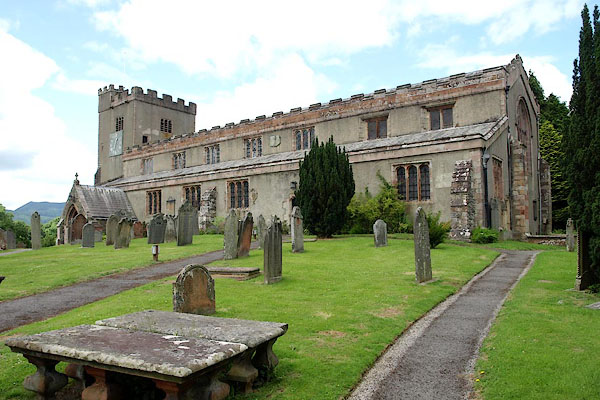
BRA27.jpg (taken 9.7.2009)
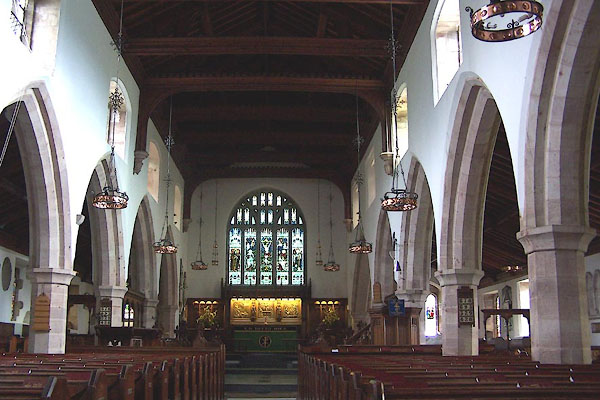
BJX87.jpg (taken 14.10.2005)
placename:- St Kentigern's Church
"St. Kentigern's Church (Vicarage) / Grave Yard"
placename:- Crosthwate church
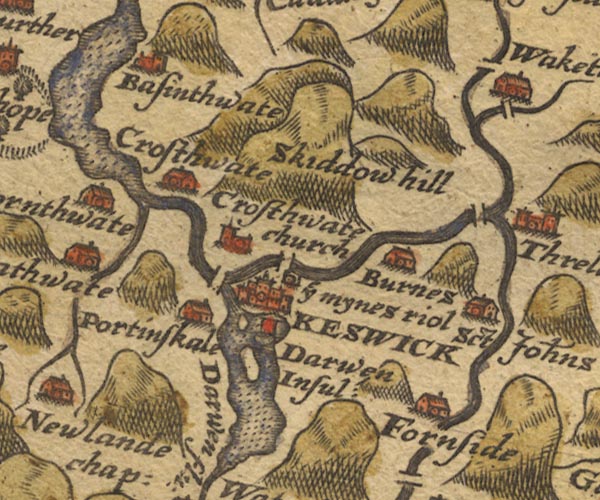
Sax9NY22.jpg
"Crosthwate church"
item:- private collection : 2
Image © see bottom of page
placename:- Crosthwaite Church
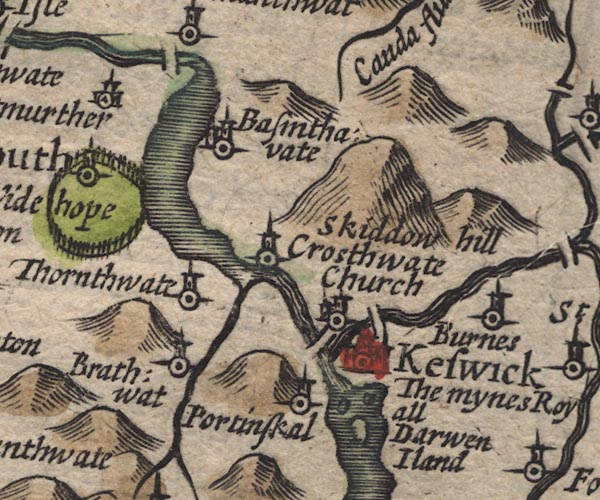
SP11NY22.jpg
"Crosthwaite Church"
circle, building, tower
item:- private collection : 16
Image © see bottom of page
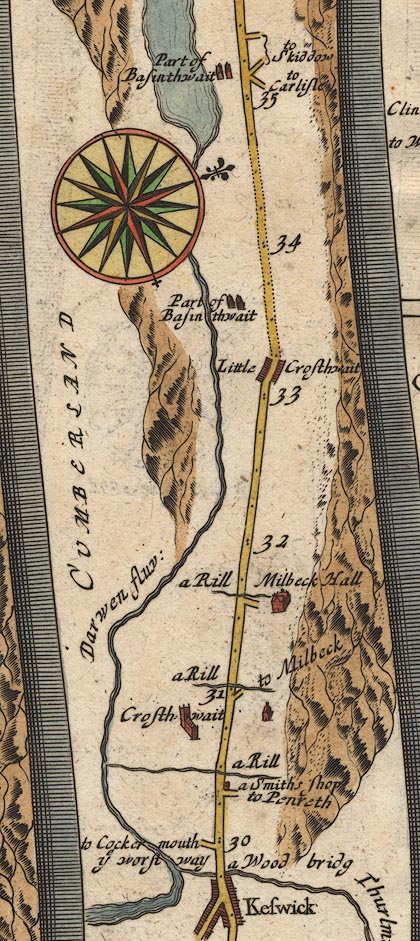
OG96m030.jpg
In mile 30, Cumberland.
church off the road to the left at:- "Crosthwait"
item:- JandMN : 22
Image © see bottom of page
placename:- Crosthwate Church
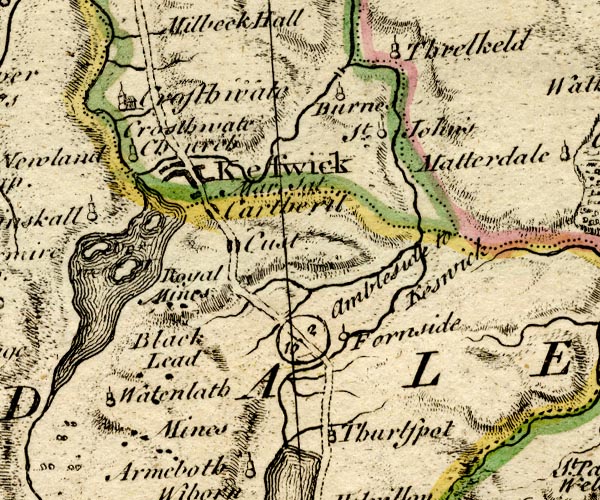
BO18NY21.jpg
"Crosthwate Church"
circle, tower
item:- Armitt Library : 2008.14.10
Image © see bottom of page
 goto source
goto sourceAddendum; Mr Gray's Journal, 1769
Page 203:- "Oct. 3. [from Keswick] ... to Borrowdale; ... beneath you, and stretching far away to the right, the shining purity of the lake-reflecting rocks, woods, fields, and inverted tops of hills, ... with the white buildings of Keswick, Crosthwaite church, and Skiddaw, for a back-ground at a distance. ... ... Behind you the magnificent heights of Wallow-crag:"
 goto source
goto sourceMrs Radcliffe's Ride over Skiddaw, 1794
Page 304:- "... that part of the vale of Keswick which separates the two lakes, and spreads a rich level of three miles, was immediately below; Crosthwaite church nearly in the centre, with the vicarage rising among trees. ..."
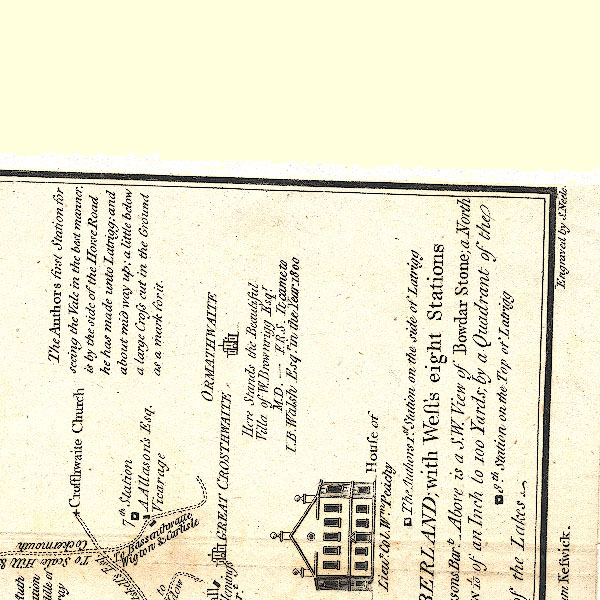
CT2NY22R.jpg
"Crosthwaite Church"
Marked by a cross.
item:- Armitt Library : 1959.191.3
Image © see bottom of page
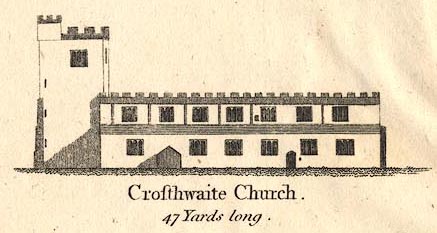
CT02Vgn4.jpg
item:- Armitt Library : 1959.191.3
Image © see bottom of page
placename:- Crossthwaite Church
 goto source
goto sourcePage 100:- "..."
"The church of Keswick, (properly called Crossthwaite Church,) is dedicated to St Cuthbert, and has under it five chapels of ease, viz. Borrowdale, St John's, Wythburn, Thornthwaite and Newlands; out of all these collectively are chosen the Church-wardens of Crossthwaite, and eighteen persons whom they call Sides-Men. These are sworn into their office on Ascension-day by the Vicar; a custom I believe used in no other place. This church is under the patronage of the Bishop of Carlisle."
placename:- Crossthwaite Church
item:- memorial
 goto source
goto sourcePage 182:- "..."
"In Crossthwaite church is a brass for sir John Radcliff and his lady 1327, ..."
placename:- Crosthwaite Church
item:- cattle
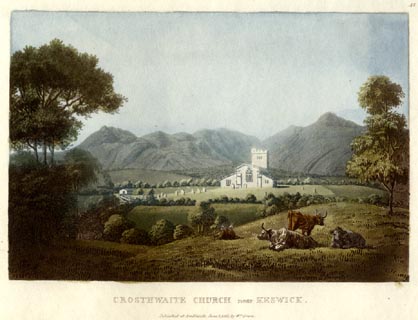 click to enlarge
click to enlargeGN0539.jpg
Plate 42 in Lake Scenery.
printed at upper right:- "42"
printed at bottom:- "CROSTHWAITE CHURCH near KESWICK. / Published at Ambleside, June 1, 1815, by Wm. Green."
item:- Armitt Library : A6646.39
Image © see bottom of page
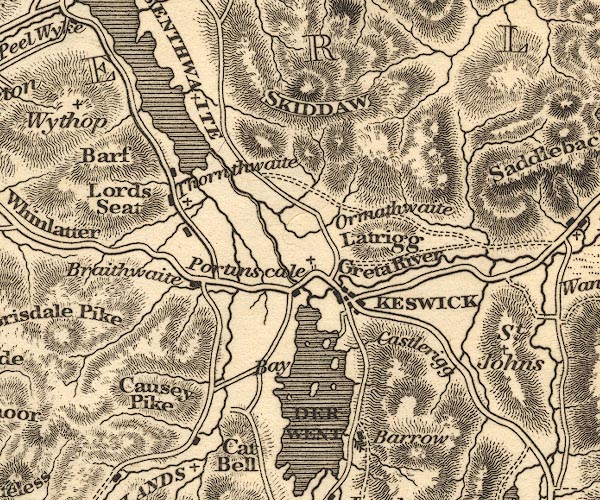
OT02NY22.jpg
Marked by a cross.
item:- JandMN : 48.1
Image © see bottom of page
placename:- Crosthwaite Church
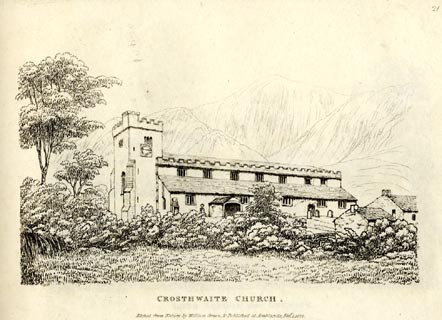 click to enlarge
click to enlargeGN1121.jpg
Plate 21 in Forty Etchings from Nature.
printed at bottom:- "CROSTHWAITE CHURCH. / Etched from Nature by William Green, &Published at Ambleside, Feby. 1, 1822."
item:- Armitt Library : A6643.21
Image © see bottom of page
item:- font
 goto source
goto sourcePage 52:- "... The parish church of Crosthwaite stands almost in the centre of this finest of vales; the parish is very extensive, containing scenery not to be surpassed, ... The church, dedicated to St. Kentigern, is a building of the age when the perpendicular style of architecture was becoming debased, and consists of a nave, with aisles and chancel. There is an interesting hexagonal font, having shields and figures carved on each of the fronts; and in one of the windows there is some stained glass. The church was anciently covered with lead, which was exchanged for a roof of slate in 1812. ..."
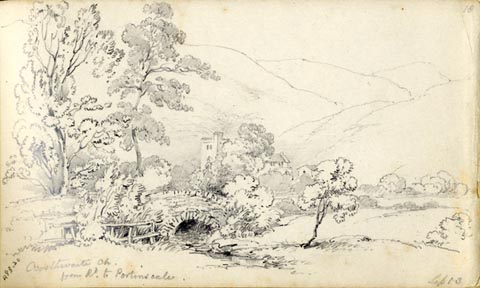 click to enlarge
click to enlargeAS0220.jpg
"Crosthwaite Ch. from Rd. to Portinscale / Sep 1-3"
page number "18"
item:- Armitt Library : 1958.488.20
Image © see bottom of page
item:- monument
 goto source
goto sourceGentleman's Magazine 1846 part 2 p.192 "... A recumbent effigy of the poet Southey, executed in marble, by Mr. Lough, of Newcastle, has been place in Crosthwaite Church, at the expense of James Stanger, Esq. The costume is a plain gown or academical robes. The right hand rests on a volume by his side; the left is placed on his breast. This is the third monument erected to the memory of the Poet, there being a bust in Bristol cathedral, and another in the Poet's Corner of Westminster abbey."
 goto source
goto sourceGentleman's Magazine 1849 part 1 p.379 "..."
"When "all the work that had entered into the heart to make for the house of the Lord was so ended," the church, displaying more than the the beauty of its early days, was rendered not only worthy to rank amongst the most splendid restored monuments of ecclesiastical antiquity in Cumberland, but a more suitable temple for the public worship of Him who inhabiteth eternity, than the dilapidated structure from which it has arisen."
"Having been in all things completed, and rendered a lasting memorial of the zeal and piety of its restorer, a plate of brass, commemorative of the under-"
 goto source
goto sourceGentleman's Magazine 1849 part 1 p.380 "[under]taking, was affixed into the third pier in the south aisle, on which is engraved the following record:-"
""On the 22nd day of June, 1844, a faculty was granted in the consistry court at Carlisle to the Rev. James Lynn, vicar of Crosthwaite, and James Stanger, of Lairthwaite, esquire, for the restoration of the chancel, the roof, and other portions of this church, according to certain plans thereof exhibited, and for the erection of a tomb and sculptured monumental figure of the late Robert Southey, poet laureate, in accordance with which faculty these restorations were completed under the direction of George Gilbert Scott, architect, and the church was re-opened for divine service on the 3rd day of August, 1845, and the monument erected A.D. 1846.""
"To a grave and recondite antiquary, this description of Crosthwaite church, and the objects of interest connected with it, will appear deficient in that fulness of information which a sedulous research through our national and diocesan archives alone can unfold. It is briefly mentioned in some of those valuable records whose pages illustrate the annals of our older churches. As such documentary evidences however, besides lying beyond the opportunities for research of the writer of these pages, are chiefly of a statistical and financial nature, which, though useful in themselves, would swell this sketch beyond reasonable limits, they are omitted without more than this concise allusion to their existence."
"The vicarage house, seated upon an eminence between the church and the town, commands that beautiful view of the Lake of Derwentwater, and the surrounding mountain scenery, with which the poet Gray, who visited this country in 1769, was so much enraptured. "From hence," says he in those delightful letters which were the medium of giving to his fellow-countrymen the first familiar account of the romantic loveliness of a region then so little frequented, "I got to the parsonage a little before sunset. and saw a picture, which if I could transmit it to you, and fix it in all the softness of its colours, would fairly sell for one thousand pounds." The point of view from which Gray beheld this fascinating prospect was from the horsing stone which then and for a long time after stood without the right hand side of the garden gate, in front of the house. It was removed several years ago, much to the regret of Mr. Southey, who often used playfully to reflect on the little sympathetic feeling shown in the destruction of a memorial so intimately associated with the author of "The Elegy.""
"As this memoir of the venerable parish church of Crosthwaite was in commencement graced with a quotation from one of the most instructive works of that eminent writer whose spirit pervades the scene, and every spot on which the eye can rest is vocal with the associations of his life, so it cannot be more fitly concluded than with another extract borrowed from the same delightful book, after which, it would be sacrilege to add one word more."
""I was walking alone in Howrah looking upon the church and upon Skiddaw behind it, which was then in the glory of a Midsummer sunset. The weight of time and eternity was on my spirit; I had been also thinking of the change in human institutions, a thought naturally connected with any permanent monuments of nature or art. The shadows glide over that mountain, and the clouds collect there, and the sun glorifies it, as they did when the Druids performed their rites within yonder circle of stones, when the Romans and romanised Britons erected altars to Jupiter and Belatucadrus, and when the Danes offered up victims to Thor and Woden. The church too has undergone its changes. The rood loft has disappeared; not a bell rings on Saint Kentigern's Day, and not a trace of the saint remains in his own parish. I was contemplating that church and yonder mountain. Seven centuries have gone by since the church was founded; and there Skiddaw has stood since the foundations of the hills were laid. My years will presently be like a tale that is told. These will remain; the one unchangeable, the other, I trust, never to be changed in its destination and uses, whatever renovations the structure may require.""
 GentsMag 1849 pp249-254
GentsMag 1849 pp249-254 GentsMag 1849 pp255-259
GentsMag 1849 pp255-259item:- monumental brass
 goto source
goto sourceGentleman's Magazine 1863 part 2 p.42 "BRITISH ARCHAEOLOGICAL ASSOCIATION."
"May 27. ..."
"... ..."
"Mr. Powell delivered in a pedigree of Derwentwater of Castle Rigg upon Derwent, and accompanied it by a rubbing of the brass of Sir John Ratcliff and Alice his wife, in Crosthwaite Church, the heraldic bearings on which were peculiarly placed."
"..."
item:- font
 goto source
goto sourceGentleman's Magazine 1863 part 1 pp.321-322
page 321:- "SOCIETY OF ANTIQUARIES OF LONDON."
"Jan. 22. ..."
"... ..."
"AUGUSTUS W. FRANKS, Director, communicated some remarks on"
page 322:- "a font and a brass in Crosthwaite Church, Keswick. The inscription on the font had never been deciphered (so far as is known) till Mr. Franks visited the church, and with his usual sagacity detected the key to the right reading."
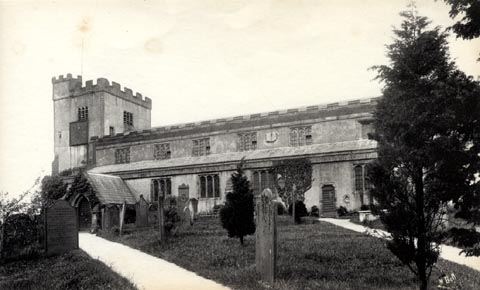 click to enlarge
click to enlargeHB0457.jpg
internegative at lower right:- "H. Bell"
stamped at reverse:- "HERBERT BELL / Photographer / AMBLESIDE"
item:- Armitt Library : ALPS116
Image © see bottom of page
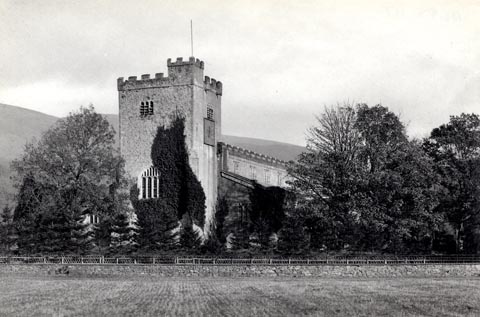 click to enlarge
click to enlargeHB0458.jpg
stamped at reverse:- "HERBERT BELL / Photographer / AMBLESIDE"
item:- Armitt Library : ALPS117
Image © see bottom of page
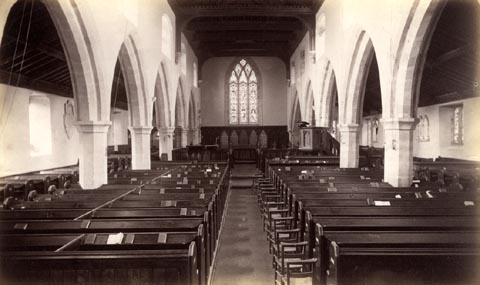 click to enlarge
click to enlargeHB0461.jpg
item:- Armitt Library : ALPS120
Image © see bottom of page
placename:- Crossthwaite Church
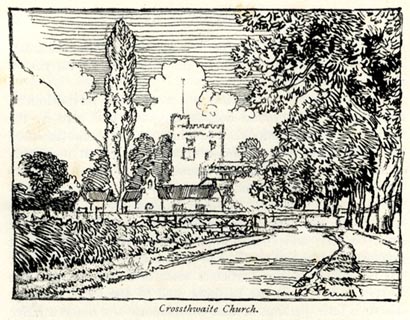 click to enlarge
click to enlargeBRL116.jpg
On page 92 of Highways and Byways in the Lake District, by A G Bradley.
printed at lower right:- "Joseph Pennell"
printed at bottom:- "Crossthwaite Church."
item:- JandMN : 464.16
Image © see bottom of page
placename:- Crosthwaite Church
item:- sheep
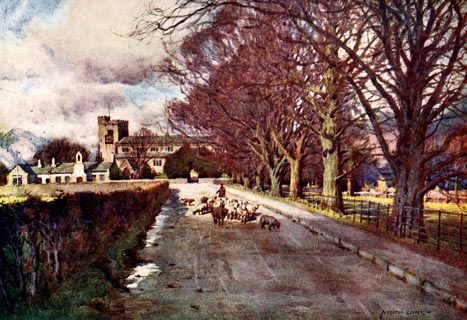 click to enlarge
click to enlargeHC0150.jpg
Opposite p.148 of The English Lakes, painted by Alfred Heaton Cooper, described by William T Palmer.
printed at tissue opposite the print:- "CROSTHWAITE CHURCH, KESWICK"
printed at signed lower right:- "[A HEATON COOPER]"
item:- JandMN : 468.50
Image © see bottom of page
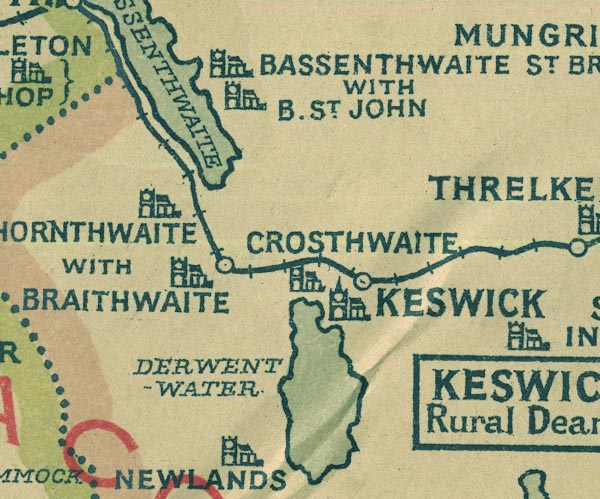
NUR1NY22.jpg
"CROSTHWAITE"
item:- JandMN : 27
Image © see bottom of page
 stained glass
stained glassplacename:- Church of St Kentigern
courtesy of English Heritage
"CHURCH OF ST KENTIGERN / / CHURCH LANE / KESWICK / ALLERDALE / CUMBRIA / II[star] / 71770 / NY2574124285"
courtesy of English Heritage
"Parish church of least C14 origin, enlarged 1523, restored 1844 by Sir George Gilbert Scott."
"MATERIALS: Roughcast walls, coursed rubble buttresses, freestone quoins and parapets, coursed rock-faced stone to porch, graded-slate roofs."
"PLAN: Long nave and chancel under a single roof, aisles, south porch and west tower."
"EXTERIOR: Mainly in Tudor-Gothic style. The 3-stage west tower has diagonal buttresses and an embattled parapet incorporating a higher south-west turret. The west doorway is under a C19 shouldered lintel and above it the 4-light window has C19 Perpendicular tracery in a C16 opening. Square-headed belfry openings have triple round-headed lights with sunk spandrels (replaced in wood to the west face), and a big south clock face is on a slate panel. The 7-bay nave and chancel have an embattled red-sandstone parapet (dated 1812) and gable. Clerestorey 3-light windows are square-headed, with round-headed lights and sunk spandrels, except the two 2- light south chancel windows which have plain mullions. In the south wall is a slate sundial with gnomon. The chancel has freestone angle buttresses and C19 5-light Perpendicular east window. The south aisle has a C19 parapet and 3 buttresses. Six 3- light windows are similar to the clerestorey windows, and a doorway under a shouldered lintel was the entrance to a chapel at the east end of the south aisle. The east window is also 3-light, the west window 2-light with ogee-headed lights. The porch is typical Scott, in Early-English style with buttresses, steep roof, and entrance with filleted shafts. Inside, the south-aisle doorway under a segmental head is a C19 renewal of an earlier doorway. The north aisle incorporates a vestry that embraces the west tower. The vestry has 4-light square-headed north and west windows. Windows in the aisle proper are also square-headed, of at least 2 phases in the C15 and C16, either with ogee-headed, cusped, or round-headed lights with sunk spandrels. There are six 2-light windows, in the first bay with wooden mullions, and two C16 3- light windows at the east end, and 2-light east window. A north doorway, corresponding with the south doorway, is round-headed with continuous moulding, of late C16 or C17 character but a C19 rebuild. There are several slate grave slabs attached to the outer walls, including 2 of the early C19 attributed to William Bromley, mason of Keswick."
"INTERIOR: The interior is wide and spacious. The double-chamfered tower arch dies into the imposts, indicating that there was a tower here before the C16. The 7-bay arcades have octagonal piers and double-chamfer arches, a dated form if they are as late as the C16. They look to be a century earlier at the latest. The eastern bay is wider. Roofs are C19. Nave and chancel have a 13-bay tie-beam roof. The truss at the junction of nave and chancel has corbelled brackets, and in the chancel the beams are castellated. Aisle lean-to roofs have moulded principals and purlins, and foliage bosses. At the east end of the north aisle are angels at the foot of the principals, indicating the former presence of a chapel. In the chancel is a re-set piscina under a Tudor head. There are 9 consecration crosses in the aisle window reveals, of 1523. Walls are plastered. Nave and aisles have stone floors except for a raised floor at the west end, and C20 polished stone floor to the baptistery in the south aisle. The chancel has a polished stone floor of 1972, the sanctuary a mosaic floor of 1889."
"PRINCIPAL FIXTURES: The font was made c1395 in commemoration of Sir Thomas of Eskhead. It is octagonal, with worn relief foliage, and a representation of the Trinity, around the bowl, on a panelled stem. Benches, probably of 1844, have ends with arms rests. In the south aisle is the Gothic frontal of a family pew dated 1826, and a Gothic box pew labelled 'J Jackson Armboth'. The C19 pulpit on a C20 stone base is polygonal with linenfold panels. The open-arcaded lectern is earlier, possibly 1844. Choir stalls have ends with poppy heads and carving on arm rests, and arcaded frontal. The back tier has curved arm rests and a screen behind it on turned balusters. The communion rail has wrought-iron scrollwork. The Tudor-panelled reredos has a shallow canopy and 3 relief brass panels, signed JB. The earliest monuments are male and female effigies, said to be Thomas Radcliffe (d 1495) and his wife, now lying in the south aisle. Next to it is a large slate slab, set up on legs like a table tomb, but originally laid in the floor and with 2ft brass effigies to Sir John Ratcliff (d 1527) and his wife. He was the chief patron of the C16 enlargement of the church. In the south aisle is a recumbent white-marble figure by J. Louth (1846) on a Gothic chest, to the poet laureate Robert Southey (1774-1843), who is buried in the churchyard. There are several other C18 and C19 wall tablets, including 2 by Webster of Kendal, C18 brass plaques in the chancel and 1914-18 war-memorial plaque by E. Harrison of Keswick. There are fragments of medieval stained glass in 2 aisle windows. The crucifixion east window is by Kempe (1897), and other windows are attributed to Wailes."
"HISTORY: The earliest features of the church are the C14 tower arch and the late C14 font. The north aisle includes some C15 windows, but the church was substantially rebuilt in the early C16 and consecrated in 1523. The tower is said to be slightly later, of c1530-35. The patron was Sir John Ratcliff, whose brass effigy is in the church. The church was extensively restored in 1844 by George Gilbert Scott (1811- 78), architect of London and the most prolific restorer of churches in the C19. Restoration was undertaken mainly at the expense of James Stanger of Lairthwaite, and was prompted by a campaign raising funds for a monument in the church to Robert Southey. Scott rebuilt the roofs and added the south porch. Some furnishings also date from Scott's restoration."
"SOURCES:"
"N. Pevsner, The Buildings of England: Cumberland and Westmorland, 1967, pp 114-15."
"Parish church of St Kentigern: Notes for Visitors."
"REASONS FOR DESIGNATION: The church of St Kentigern, Crosthwaite, is designated at Grade II[star] for the following principal reasons: [bullet] It is a substantial late-medieval parish church retaining significant original fabric and detail. [bullet] It has fixtures of special interest, including a rich late C14 font, and good- quality C19 benches, lectern and chancel fittings. [bullet] Its monuments are of special interest, including C15 effigies, C16 brass, and C19 effigy, by the noted sculptor, J. G. Lough. The latter commemorates the poet-laureate Robert Southey, who is buried in the churchyard. [bullet] Its restoration was carried out with sensitivity by the great Gothic Revival architect, (Sir) George Gilbert Scott."
 memorials, Ratcliffe
memorials, Ratcliffe memorials, Southey
memorials, Southey memorials
memorialsplacename:- Crosthwaite Church
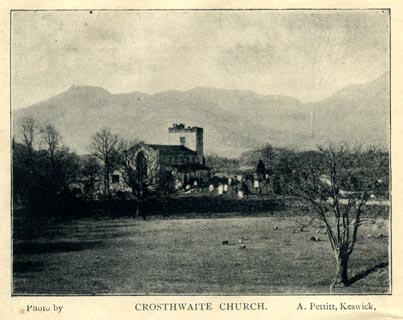 click to enlarge
click to enlargeHW1E06.jpg
In a Guide to Keswick and its Vicinity in the Penny Guide Books series.
printed at bottom:- "Photo by / CROSTHWAITE CHURCH. / A. Pettitt, Keswick."
item:- JandMN : 348.6
Image © see bottom of page
placename:- Crosthwaite Church
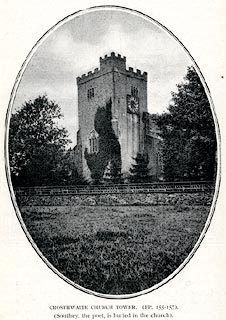 click to enlarge
click to enlargePS1E57.jpg
On p.156 of Pearson's Gossipy Guide to the English Lakes and Neighbouring Districts.
printed at bottom:- "CROSTHWAITE CHURCH TOWER. (pp.155-157). / (Southey, the poet, is buried in the church)."
item:- Armitt Library : A1188.64
Image © see bottom of page
item:- religion
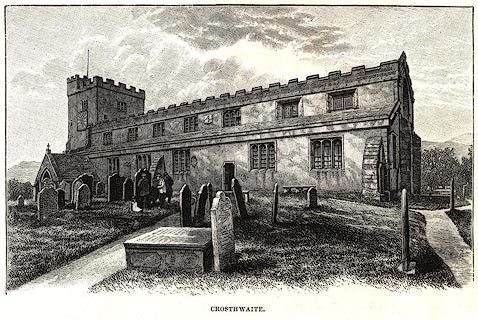 click to enlarge
click to enlargePR0571.jpg
printed at bottom:- "CROSTHWAITE."
item:- Dove Cottage : 2008.107.519
Image © see bottom of page
item:- stone; Bolster Stone
The Bolster Stone:-
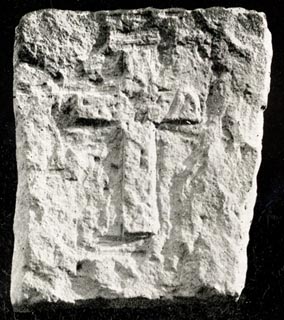 click to enlarge
click to enlargeCV1078.jpg
Photograph by W L Fletcher.
item:- JandMN : 190
Image © see bottom of page
placename:- Crosthwaite Church
item:- religion
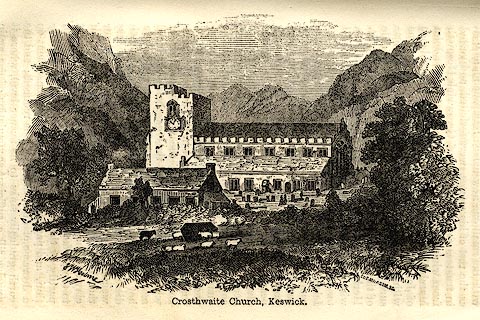 click to enlarge
click to enlargeAK2E10.jpg
On p.57 of a Handbook to the English Lakes, 5th edn.
printed at bottom:- "left, right, centre: : T W Holme / GEO. MEASOM. SC. / Crosthwaite Church, Keswick."
item:- Armitt Library : A1144.11
Image © see bottom of page
 ring of bells
ring of bells| Wethamsted, Jeffry | 1294 - |
| Graystoke, Richard de | 1313 - |
| Lune, Thomas | 1354 - |
| Broughton, John Henry de | 1359 - |
| Welton, John de | 1360 - |
| Morland, Peter de | 1361 - |
| Boon, John | 1362 - |
| Eskhead, Thomas de | 1363 - |
| Ratcliffe, John | 1547 - |
| Maybraye, John | 1567 - |
| Mayson, Peter | 1585 - |
| Beck, Robert | 1592 - |
| Beck, Peter | 1597 - |
| Robinson, Giles | 1602 - |
| Singleton, Isaac | 1623 - |
| Winter, John | 1643 - |
| Mees, William | 1653 - |
| Ratcliffe, Percival | 1654 - |
| Studdert, J | 1660 - |
| Marshall, Henry | 1661 - |
| Lowrie, Richard | 1667 - |
| Tullie, Thomas | 1710 - |
| Nicholson, Thomas | 1727 - |
| Christian, Thomas | 1728 - |
| Lushington, James S | 1770 - |
| Denton, Henry | 1780 - |
| Denton, Isaac | 1786 - |
| Lynn, James | 1820 - |
| Gipps, Henry | 1855 - |
| Goodwin, George G | 1878 - |
| Richmond, Thomas K | 1878 - |
| Rawnsley, Hardwick Drummond, Canon | 1883 - |
 sundial
sundial scratch dial?
scratch dial?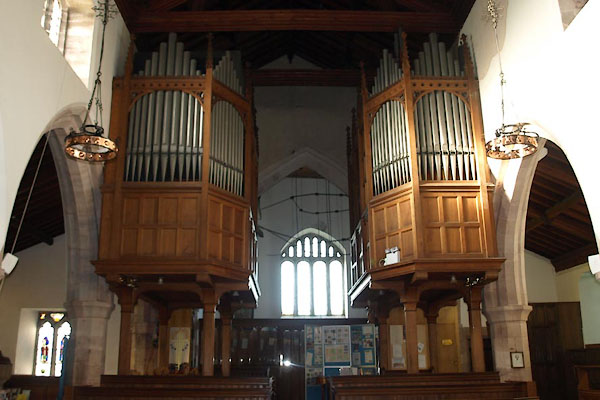
BVP41.jpg Organ, made by Bishop, London, 1837, enlarged by Jardine, Manchester, 1920..
(taken 5.11.2011)
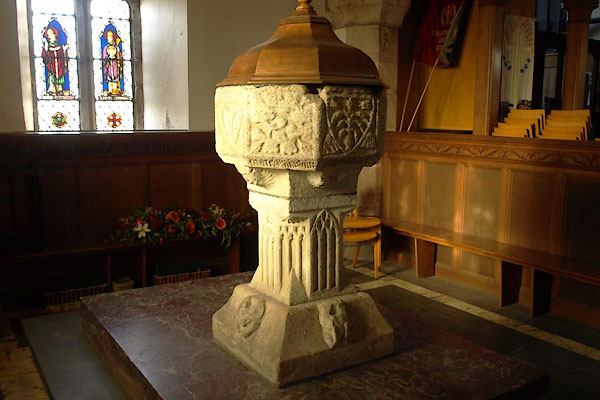
BVP40.jpg Font.
(taken 5.11.2011)
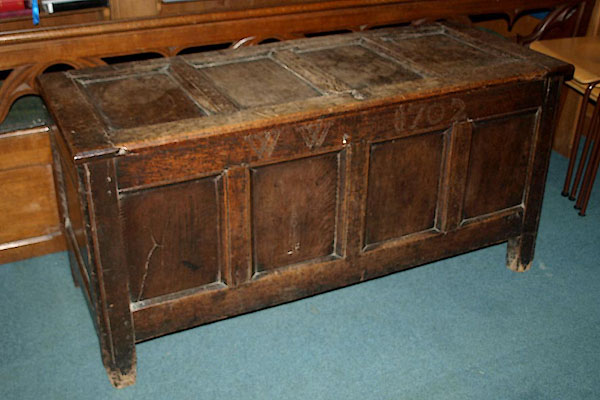
BVP46.jpg Parish chest, 1702
(taken 5.11.2011)
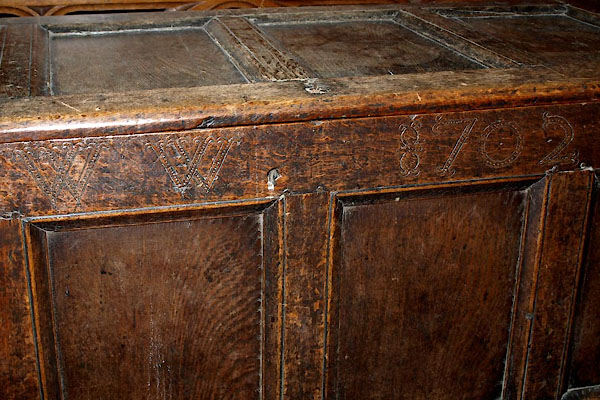
BVP47.jpg Parish chest:-
"WW 1702" (taken 5.11.2011)
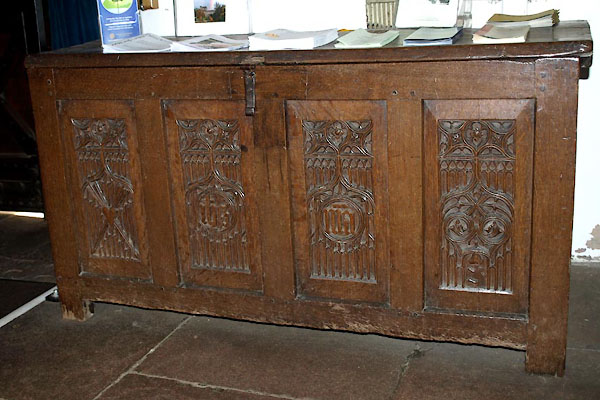
BVP63.jpg Parish chest:-
(taken 5.11.2011)
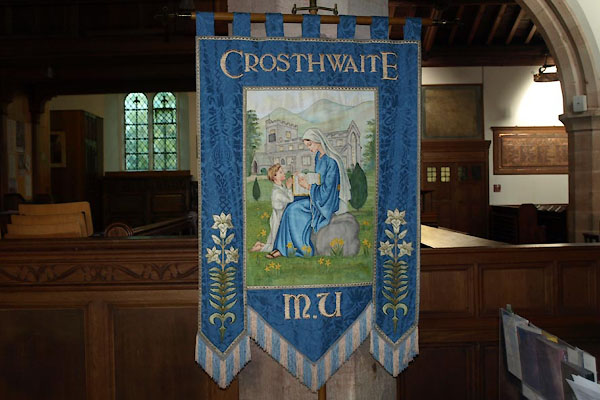
BVP42.jpg Mothers Union banner.
(taken 5.11.2011)
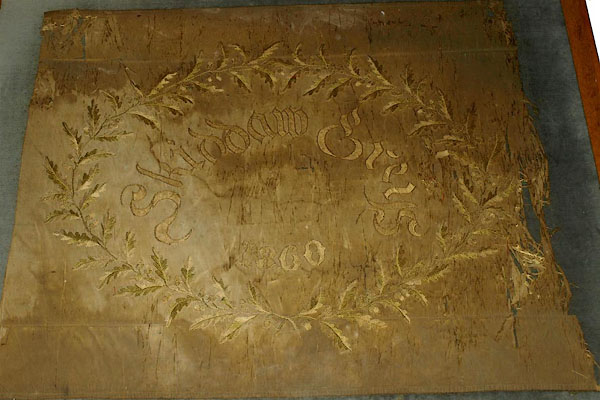
BRA43.jpg Colours of the Skiddaw Greys; Keswick Company of the 1st Volunteer Border Regiment.
(taken 9.7.2009)
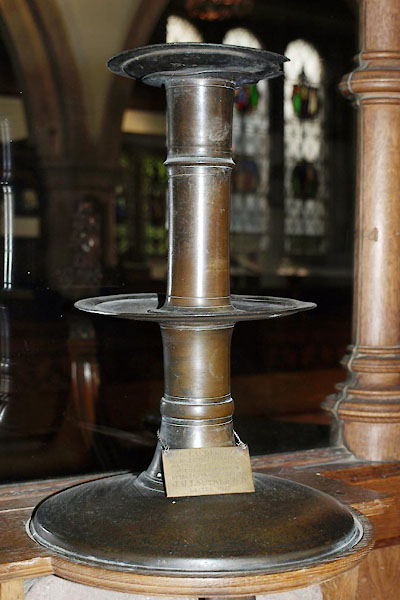
BVP52.jpg Candlestick.
(taken 5.11.2011)

BVP53.jpg Candlestick, label.
(taken 5.11.2011)
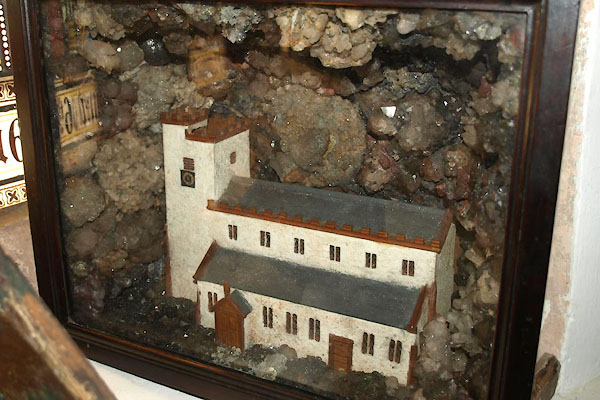
BVP54.jpg Model of the church in a spar box.
(taken 5.11.2011)
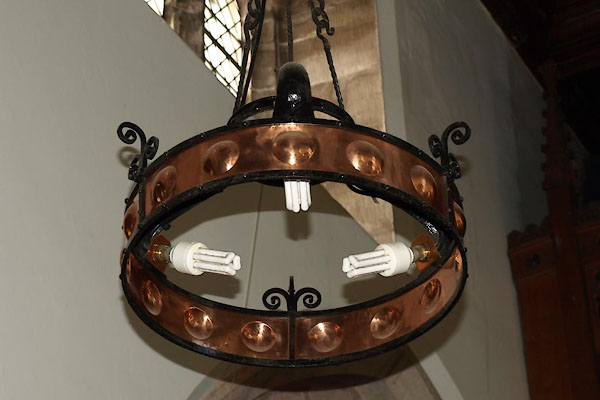
BVP43.jpg Light fitting - and very ugly lights.
(taken 5.11.2011)
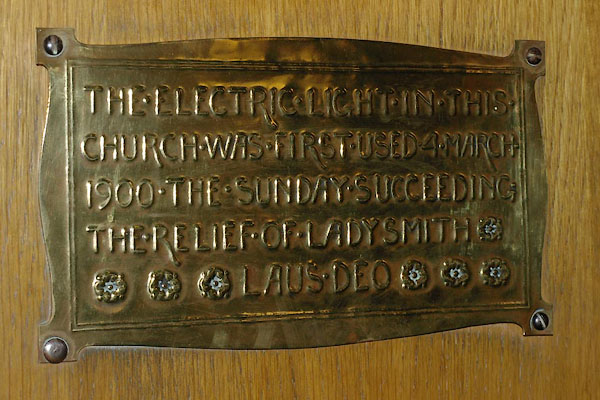
BVP48.jpg Notice regarding electric lights.
(taken 5.11.2011)
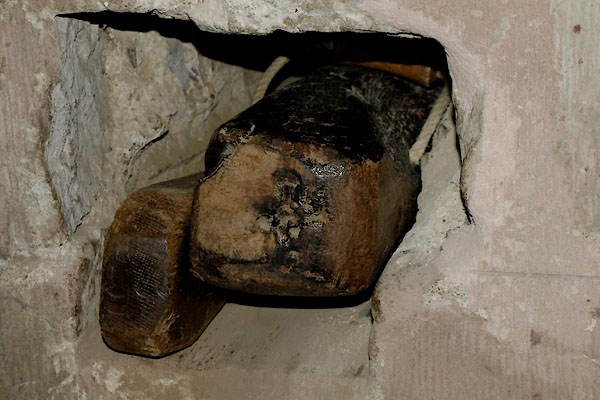
BYJ02.jpg The locking bar to the church door.
(taken 21.5.2013)
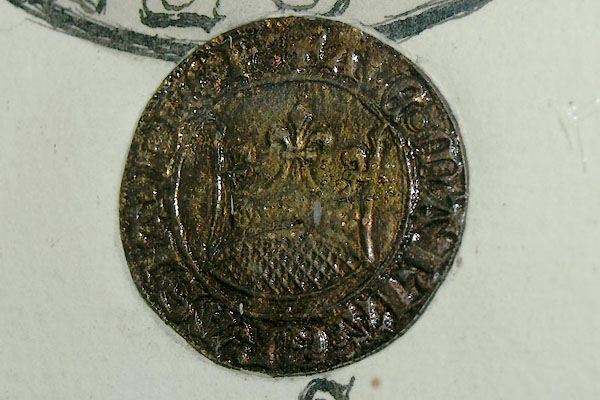
BVP58.jpg A jetton, or casting counter, found in a church wall.
(taken 5.11.2011)
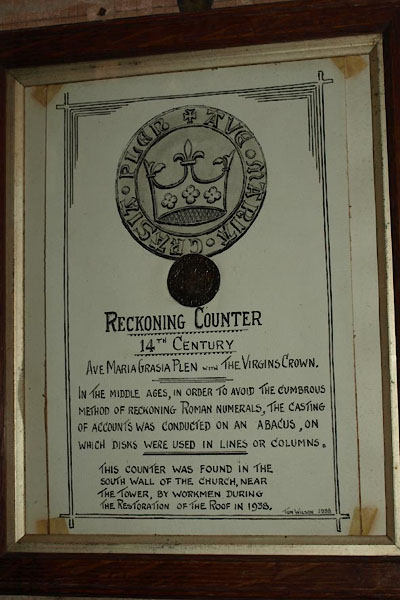
BVP59.jpg Notes about the jetton.
(taken 5.11.2011)
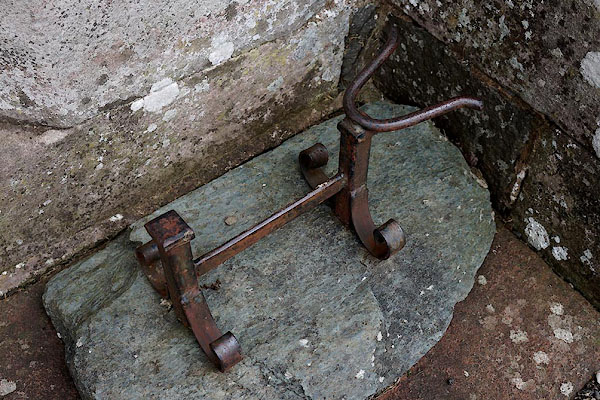
CBA81.jpg A humble boot scraper and boot jack.
(taken 9.7.2014)
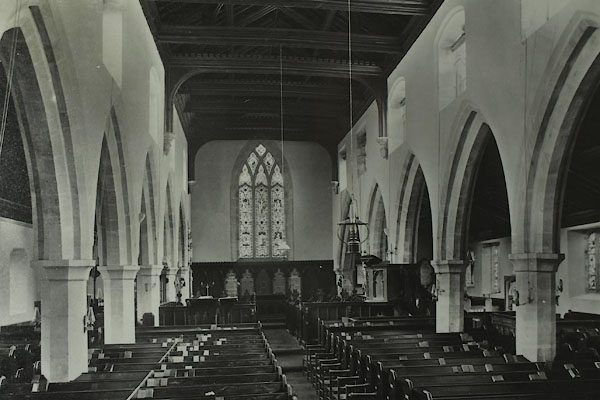
BVP51.jpg Photograph, about 1886.
(taken 5.11.2011)
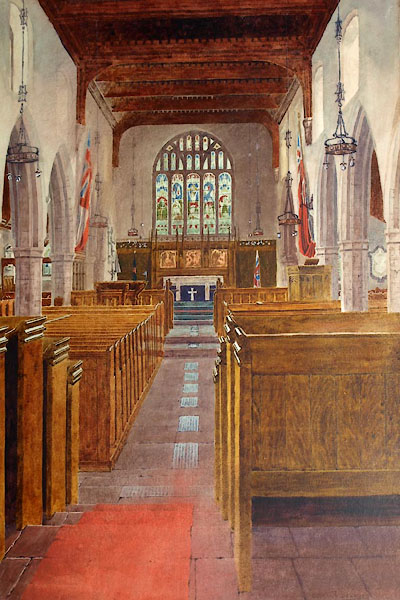
BVP49.jpg Watercolour painting, 1900s?
(taken 5.11.2011)
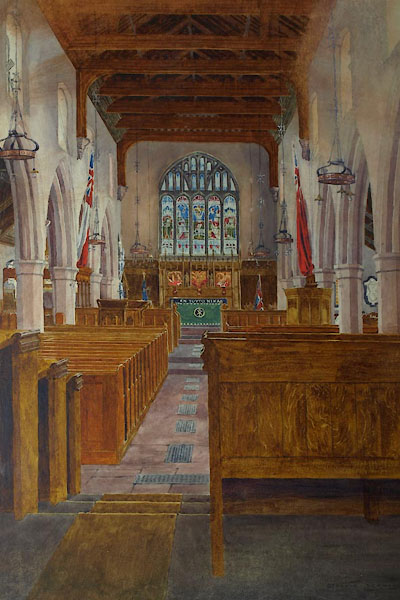
BVP50.jpg Watercolour painting, 1900s?
(taken 5.11.2011)
: Southey, Robert
